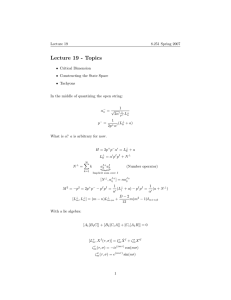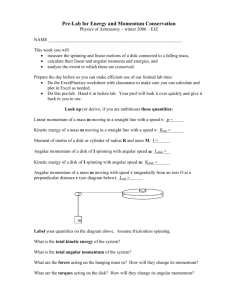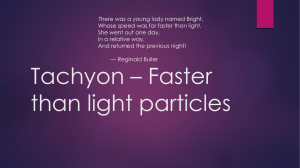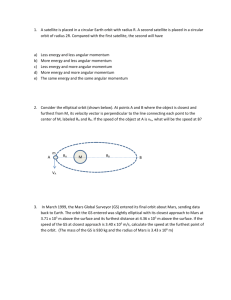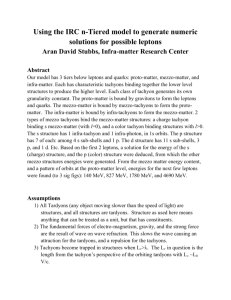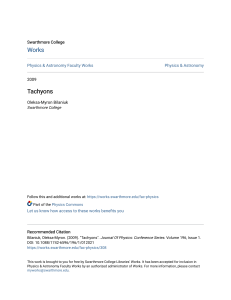Structure - Inframatter Research Center
advertisement
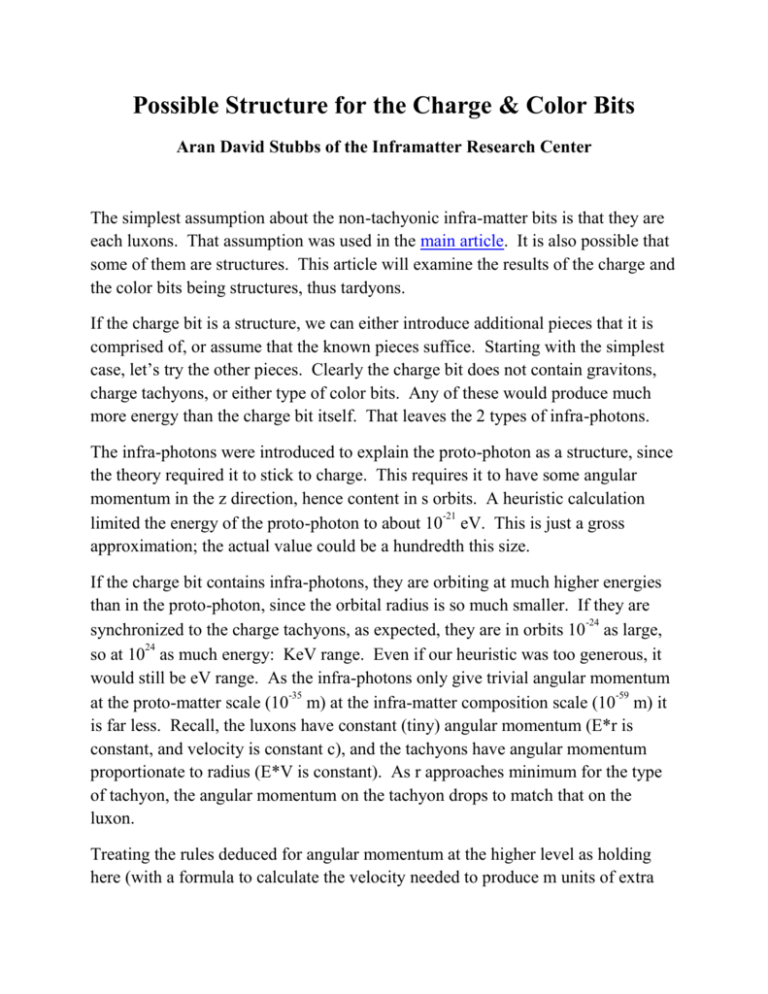
Possible Structure for the Charge & Color Bits Aran David Stubbs of the Inframatter Research Center The simplest assumption about the non-tachyonic infra-matter bits is that they are each luxons. That assumption was used in the main article. It is also possible that some of them are structures. This article will examine the results of the charge and the color bits being structures, thus tardyons. If the charge bit is a structure, we can either introduce additional pieces that it is comprised of, or assume that the known pieces suffice. Starting with the simplest case, let’s try the other pieces. Clearly the charge bit does not contain gravitons, charge tachyons, or either type of color bits. Any of these would produce much more energy than the charge bit itself. That leaves the 2 types of infra-photons. The infra-photons were introduced to explain the proto-photon as a structure, since the theory required it to stick to charge. This requires it to have some angular momentum in the z direction, hence content in s orbits. A heuristic calculation -21 limited the energy of the proto-photon to about 10 eV. This is just a gross approximation; the actual value could be a hundredth this size. If the charge bit contains infra-photons, they are orbiting at much higher energies than in the proto-photon, since the orbital radius is so much smaller. If they are -24 synchronized to the charge tachyons, as expected, they are in orbits 10 as large, 24 so at 10 as much energy: KeV range. Even if our heuristic was too generous, it would still be eV range. As the infra-photons only give trivial angular momentum -35 -59 at the proto-matter scale (10 m) at the infra-matter composition scale (10 m) it is far less. Recall, the luxons have constant (tiny) angular momentum (E*r is constant, and velocity is constant c), and the tachyons have angular momentum proportionate to radius (E*V is constant). As r approaches minimum for the type of tachyon, the angular momentum on the tachyon drops to match that on the luxon. Treating the rules deduced for angular momentum at the higher level as holding here (with a formula to calculate the velocity needed to produce m units of extra a b angular momentum for a structure in a ns orbit where b a m , and V c , of ab ( 2 n m) 2 ), we can look at the energy content as “rest” energy in the m context of the charge bit. Then the 1s charge bit has n=1, and an integer m. If m is 1 as well, the charge bit is moving 4/5 c and the “rest” energy of its contents are 3/5 its total energy. If all 3 charge bits in a proto-electron have the same rest energy (that is they are each the same radius), they total 9/33 the energy of the proto-electron (48.2074 KeV cumulatively), so the rest energy of each charge bits content is 4382 eV. The other 24/33 of the energy of the proto-electron is divided as before among the 3 tachyons and the 3 tardyons, proportionate to their n/p*, where p* is 12 – the sum of the 6 n’s. A more likely scenario has each charge bit with its own integer m, varying in radius (that is energy). Of the many possible values of m in this scenario, it is possible to calculate in some simple instances. Where each of the 3 has m=1, the 2s charge bit is travelling 12/13 c, and the 3s is travelling 24/25 c. The 2s has 5/13 of its total energy as rest, and 8/13 as kinetic. The 3s has 7/25 of its total energy as rest, and 18/25 as kinetic. Solving for 1s kinetic energy, we get 12/191 the protoelectron’s total energy, or 3.0285 KeV. The 1s rest energy is 3/2 this or 4.5428 KeV, with 2s rest energy of 5/4 the 1s KE or 3.7857 KeV, and 3s rest energy of 7/6 the 1s KE or 3.5333 KeV. In general, for this pattern, the ns piece has rest energy of 2n+1/2n of the 1s’s kinetic energy. Most of these have a common problem: they don’t have a frequency lock to the charge tachyons, as the luxon solution gives. The exception is the m=kmnn/6 cases, with the same velocity for each n. In this context the luxon solution is m=0n. If the only requirements are frequency lock and integer overall angular momentum kmn is a small integer: kmn 0 1 2 3 4 5 6 12 V/c 1 84/85 24/25 12/13 15/17 132/157 4/5 3/5 Rest Energy: Kinetic 0:1 13:72 7:18 5:8 8:9 85:72 3:2 4:1 1s RE (KeV) 0 0.665 283 1.307 954 1.912 994 2.472 177 2.982 266 3.443 389 5.356 383 1s KE (KeV) 4.017 287 3.684 645 3.363 310 3.060 790 2.781 199 2.526 155 2.295 593 1.339 096 Of course, if the only requirement is the frequency lock, kmn can be any nonnegative real number. The Kinetic energy ratio above is the amount for each tardyon, the various tachyons have matching kinetic energy, thus the total ratio is half the piece ratio (so kmn=6 has 3 parts rest energy to 4 parts kinetic overall). There may also be solutions for frequency lock where velocity is not constant across types, but is a ratio of some kind. So for instance the 1s may have an orbit for every 12 charge tachyon orbits, while the 2s has 1 for every 6 or 8, and the 3s has 1 for every 4 or 6. Here, case 1 is where ratio is to n (V2s = 2V1s), while case 2 is to n+1 (2V2s = 3V1s). These have a very small limit to maximum n. Which of the many possible solutions is the correct solution requires leaving the energy and angular momentum balances and looking at the force balance. Each charge bit is pulled inward by its own and the other 2 tachyons. They would then in turn be pulled outward by centripetal effects (which are proportionate to kinetic energy), the tug of the other 2 charge bits, and contact with other structures (especially the proto-photons). No numeric solution was isolated to distribute the energy of the charge bit since no elliptic orbits occur, but a numeric solution was found for the color bit with kmn=2. This required a proto-muon with color bits in the 2p orbits, so the color bits have energy around 1.13 MeV in 1s orbits, and a rest energy for the tardyon structure around .201 MeV. This led to a proton with 3 total proto-pions and a diameter of 1.6811 fm. The solution may not be unique, but was the first good case. Treating the energy content of the luxon infra-photons as proportionate to the base frequency of the tachyons they are bound to (not the tachyon infra-photons), we can make a first attempt at the content of the color bits. For gravitons, this energy -21 -35 was about 10 eV at a radius about 10 m. For charge tachyons it looks to be a -59 few KeV at a radius about 10 m. For color tachyons it looks to be about a MeV -62 at a radius about 10 m. That suggests a base frequency about 307 times that of the charge tachyons (if they have parallel structures), since this is the ratio of their 1s energies. As the angular momentum is a function of the radius, and the base frequency (which for a given wavelength is proportionate to velocity), this suggests a huge angular momentum for the color tachyons as their orbits are similar in size to the charge tachyons: about 94,400 times as much angular momentum, the square of their energy ratio. A better solution would parallel the color bit to the proto-pion. Instead of 2 infraphotons within, it would have 10, occupying the 1s, 2s, and 2p orbits. Instead of a base frequency 307 times the charge tachyons, it is 29.9 times the frequency. The angular momentum in this case is only 895 times that of the charge tachyon or about 2089 small units. This is still a lot, but not quite so overwhelming. The small size of the color bit implies a very small size for the infra-photon, less -62 than 10 m in radius. Possibly much less. The radius of the proto-matter was initially calculated as 𝐿𝑃 /√12, but this only holds for luxon-like proto-matter. A more accurate radius is 𝐿𝑃 𝑉/𝑐√12, where the V is the velocity of the proto-matter from a neutral perspective. This ties the orbital frequency of the infra-photons, either directly or within the intermediate structures, when in s-orbitals to the gravitons frequency. The frequency of the infra-photons within the charge bit or color bit is similarly proportionate to the relevant granularity constants there.

